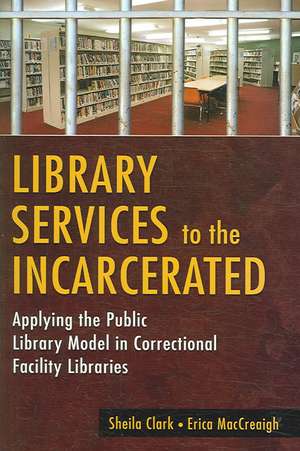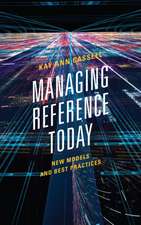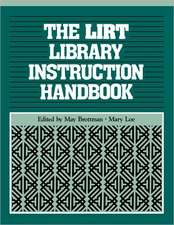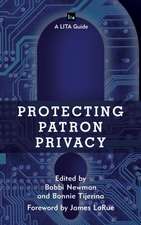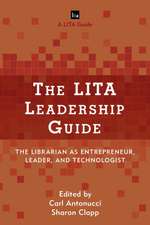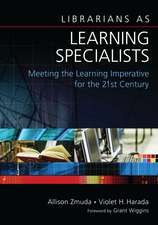Library Services to the Incarcerated: Applying the Public Library Model in Correctional Facility Libraries
Autor Sheila Clark, Erica Maccreaighen Limba Engleză Paperback – 29 aug 2006 – vârsta până la 17 ani
Preț: 239.00 lei
Nou
Puncte Express: 359
Preț estimativ în valută:
45.74€ • 49.66$ • 38.42£
45.74€ • 49.66$ • 38.42£
Carte tipărită la comandă
Livrare economică 22 aprilie-06 mai
Preluare comenzi: 021 569.72.76
Specificații
ISBN-13: 9781591582908
ISBN-10: 1591582903
Pagini: 264
Dimensiuni: 156 x 235 x 19 mm
Greutate: 0.42 kg
Editura: Bloomsbury Publishing
Colecția Libraries Unlimited
Locul publicării:New York, United States
ISBN-10: 1591582903
Pagini: 264
Dimensiuni: 156 x 235 x 19 mm
Greutate: 0.42 kg
Editura: Bloomsbury Publishing
Colecția Libraries Unlimited
Locul publicării:New York, United States
Notă biografică
Sheila Clark is Library Supervisor, Arapahoe Library District, Detention Facility Library in Centennial, Colorado and has also worked in public and public school libraries, and a synagogue library. Sheila also is involved in the Begin With Books in Jail and Choose Freedom-READ! programs.Erica MacCreaigh served four years as a senior library consultant to the Colorado Department of Corrections. She is now back in jail doing what she loves best-working directly with inmate library patrons.
Cuprins
AcknowledgmentsIntroductionWhy Correctional Libraries?History of Correctional LibrariesThe Importance of Correctional LibrariesWhy This Book?OrganizationA Word of CautionScope and AudienceChapter 1: The Public Library ModelAccess and Intellectual FreedomPrivacy and ConfidentialitySocial ResponsibilityModels of ServiceIn-House ServiceLibrary as DestinationLibrarian as "Information Concierge"Librarian as EducatorOutreach-On the InsideLibrary as Community OutreachLibrary as Window to the WorldConclusionChapter 2: Understanding YourselfFive Types of Corrections LibrariansThe TerminatorThe Church LadyThe RealistThe People PleaserThe CrusaderDo You Belong Behind Bars?Personal QualitiesDeterminationKnow Your LimitsKnow ThyselfPatienceHealthy Lack of PerfectionismGood BoundariesNamesTouchingFlexibility and AdaptabilityHigh Tolerance for AmbiguityAgoraphobics, Please Apply!Sense of HumorProfessional QualitiesTrustworthinessStrong Customer Service Ethic and SkillsAbility to Cope with Criticism, Confrontation, and ConflictGood BoundariesDiplomacy, Tact, and SalesmanshipStamina: Or, the Ability to Work Alone for Long Periods of TimeAbility to Reinterpret Library Bill of Rights and Freedom to Read Statement for a Correctional EnvironmentBroad Knowledge of Library FunctionsRewards of Service to Inmate PatronsInstant GratificationService to the Traditionally UnderservedOpportunities to Develop Cooperative Relationships with Nonlibrary AgenciesSomething New Every DayUnderstanding Your RolePersonal Challenges and How to Surmount ThemFearIntimidationSexual HarassmentPhysical/Romantic AttractionConclusionChapter 3: Understanding the PatronsInmate Demographics in the United StatesFemale Inmates and PrisonersJuvenile OffendersProfiles of Inmate BehaviorThe BullyThe NarcissistThe Charmer (aka "Romeo")The Suck-Up (also known as The Brown-Noser)The Jailhouse LawyerThe Pod Father (or Mother)Staying SafeCreating Your Safety NetFan Clubs and Fan MailUser NeedsDesignated BudgetPatron InputResponse TimeNew Books that Don't Smell Like ToothpasteConclusionChapter 4: Understanding the SystemDifferent Types of Facilities and How They OperateJailPrisonCommunity CorrectionsJuvenile FacilitiesRegulations and StandardsWorking with Other StaffEthics and AccountabilityChallenges and How to Handle ThemChallenges to Your ServicesPhilosophical ChallengesFiscal ChallengesChallenges to Your MaterialsMutually Agreed Upon Selection PolicyChallenged Materials ProcessConclusionChapter 5: Facilities and EquipmentPhysical SpaceSeatingShelvingLightingStaff WorkspaceComputer Technology and EquipmentBasic-and Not-So-Basic-Equipment NeedsComputer TechnologyFor StaffFor PatronsChallenges and How to Surmount ThemChapter 6: Collection DevelopmentCommunity Needs AssessmentsPatron RequestsSurveysCommunity Forums or Focus GroupsInterviewsCollection Development PolicySelectionLeisure ReadingLiteracyLegal ResourcesOther Fancy StuffMagazines and NewspapersMovies and MusicForeign Language and Special Needs CollectionsCurriculum SupportForbidden FruitHardcover versus PaperbackDeposit CollectionsAcquisitionPurchasingDonationsInterlibrary LoanCataloging and ClassificationCataloging NonfictionClassifying FictionDeselectionOngoing EvaluationChapter 7: Circulation and CatologingAccessCirculation PolicyCirculation ProceduresChecking OutChecking InPatron RegistrationShelving MaterialsPreserving the CollectionChapter 8: StaffingThe Hiring ProcessStaffing Needs AssessmentThe Job DescriptionPosting the Opening and Actively Recruiting"Auditions" and InterviewsThe Background CheckTraining and MotivationTraining New StaffOngoing Professional DevelopmentMotivationVolunteersInmate Workers ("Trusties")Chapter 9: Services and ProgramsLogistical ConsiderationsUser NeedsThe Cardinal Rules of Program PlanningRecreational ProgramsA Cup of Sugar from My Dear GrannyPrograms that Might Not "Go Over"Literacy ProgramsLaw LibraryReference ServiceTraining for Legal ResearchErica and Sheila's Top Ten List of Questions Asked by Jail InmatesChapter 10: BudgetYour Plan, Their MoneyPresenting and Defending Your BudgetStating Your CaseCourting Strategic AlliesWhat to Do When the Money is Not ForthcomingGrantsChapter 11: Community CollaborationHistory of the Library/Corrections Partnership in Arapahoe County, ColoradoAdvocacy and ActivismPublic RelationsProfessional OrganizationsALA and CompanyState Library AssociationsAssociation of Bookmobiles and Outreach ServicesACLUAmerican Correctional AssociationConclusionGlossary of TermsAppendix A "Must-Have" Core Collection SuggestionsAppendix B Job DescriptionsGeneric Library Supervisor PositionGeneric Library Clerk/Library Assistant PositionGeneric Inmate Clerk PositionAppendix C Sample Interview QuestionsAppendix D Performance MeasuresSuggested ReadingsIndex
Recenzii
Library Services to the Incarcerated: Applying the Public Library Model in Correctional Facility Libraries should be of interest not only to prison librarians, but also to public libraians who deal with ex-offenders and with the population as a whole since this book deals with issues that have broader public implications. In addition, the book is truly entertaining, informational, and inspirational as it shows how prison librarians honor ALA's highest ideals while abiding by the correctional facility rules..The descriptive nature of the book makes it a wonderful resource for anyone considering working in a prison..While working with the incarcerated does seem challenging, the practical, down-to-earth tone of the book does successfully sell this career path to those who desire an interesting and varied work day.
It is not strictly a how-to manual. The conceptual back-story is full of energy, passion and conviction. It's about ethics and integrity, about being true to libraries and librarianship. The authors confront the most important ethical question of all--access..This book could help correctional administrators to appreciate the value of the library, recognize the value added to the culture of the facility by library programs, and support the enthusiasm of a librarian's effort to get to yes.
The authors..[o]ffer a down-to-earth approach to their subject, providing an enlightening view of the correctional library environment by discussing not just the library, but the incarceration system as a whole. Librarians can achieve excellence in service by applying the public library model to the jail or prison environment, placing an emphasis on equitable access for all. The book is an interesting and informative commentary on the world of the correctional library, and, with its anecdotes and wise counsel, it is not only practical and useful, it is also entertaining..This book is an informative and valuable resource for any librarian who may find him or herself working in a correctional facility, or who may be contemplating a career move to this field. It offers a wealth of helpful advice on how to succeed in the prison environment, and the authors' realistic approach and inclusion of ample illustrations make it especially appealing.
It is not strictly a how-to manual. The conceptual back-story is full of energy, passion and conviction. It's about ethics and integrity, about being true to libraries and librarianship. The authors confront the most important ethical question of all--access..This book could help correctional administrators to appreciate the value of the library, recognize the value added to the culture of the facility by library programs, and support the enthusiasm of a librarian's effort to get to yes.
The authors..[o]ffer a down-to-earth approach to their subject, providing an enlightening view of the correctional library environment by discussing not just the library, but the incarceration system as a whole. Librarians can achieve excellence in service by applying the public library model to the jail or prison environment, placing an emphasis on equitable access for all. The book is an interesting and informative commentary on the world of the correctional library, and, with its anecdotes and wise counsel, it is not only practical and useful, it is also entertaining..This book is an informative and valuable resource for any librarian who may find him or herself working in a correctional facility, or who may be contemplating a career move to this field. It offers a wealth of helpful advice on how to succeed in the prison environment, and the authors' realistic approach and inclusion of ample illustrations make it especially appealing.
